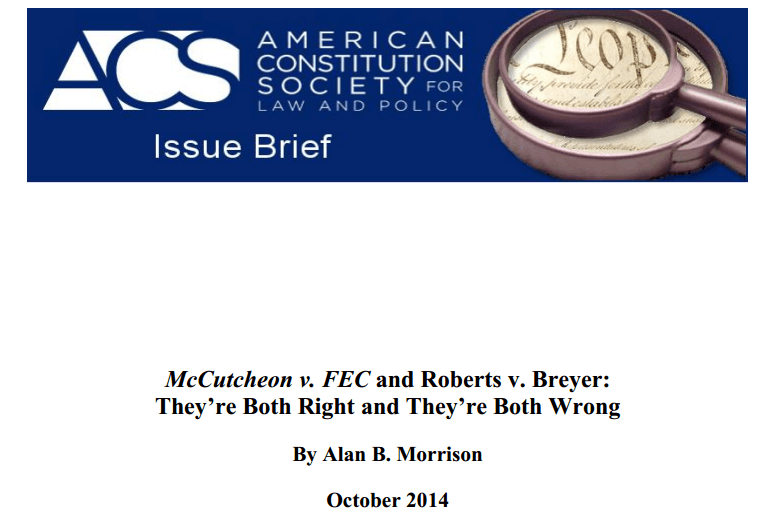October 15, 2014
Private: Revisiting Campaign Finance Reform: From Buckley to McCutcheon
ACS Issue Brief, Alan B. Morrison, Buckley v. Valeo, Campaign Finance, campaign finance reform, Justice Stephen Breyer, McCutcheon v. FEC

This past spring, McCutcheon v. FEC dealt the latest in a series of blows to campaign finance reform, striking down aggregate limits on the total amount of money a person can contribute to all candidates, parties, and PACs. Chief Justice Roberts wrote the opinion for the majority of the Court and Justice Breyer dissented. In this ACS Issue Brief, Alan Morrison asserts that while “the Chief Justice is right that the prior decisions of the current Court, as well as some of its predecessors dating back to Buckley v. Valeo, almost certainly support his conclusion on the invalidity of aggregate limits…Justice Breyer has by far the better argument that our democracy and the Constitution permit campaign finance laws that prevent more than what the majority will allow.”
By the time the Court considered the aggregate limits in McCutcheon, most of the arguments in defense of such limits and other campaign finance reforms had been gradually eroded by the Court’s previous cases. The only defense to aggregate limits in McCutcheon was an argument that, without such limits, donors would be able to circumvent limits on contributions to parties, candidates, and PACs. However, there were a number of weaknesses in this defense, and given the Court’s decision in Buckley v. Valeo, it could hardly withstand scrutiny. Thus, the Court struck the aggregate limits as unconstitutional.
However, had the Court ruled more narrowly in Buckley v. Valeo nearly forty years ago, aggregate limits and other reasonable reforms might be able to withstand First Amendment scrutiny. Buckley struck down limits on candidates spending from their own funds, on total spending by candidates from all sources, and on independent expenditures from individuals other than candidates, and in doing so ruled that the government can never limit total spending in any circumstance. By failing to recognize that some limits may be constitutional under some circumstances, the Court sowed the seeds for McCutcheon. “While perhaps not literally compelled by prior rulings, McCutcheon applied them faithfully and had to take only a very small step in order to conclude that” the aggregate limits could not stand.
But it didn’t have to be this way. The Court could have chosen from a number of narrower grounds for finding the limits in Buckley unconstitutional. In this Issue Brief, Morrison outlines some of these alternatives and describes how they would have left the Congress, and the Court, with more room to balance the competing interests at stake in campaign finance reform. Had the court adopted a more inclusive definition of corruption, and recognized that there are “strong interests in preserving our democracy and in not having those with extreme wealth dominate our political debates,” some reasonable reforms might have been upheld. In the end, Morrison concludes, Breyer was “fundamentally right about balancing the First Amendment and other legitimate interests of society, but to get to that point, the Court needs to return to the erroneous part of Buckley from which the current decisions inevitably flow.”




